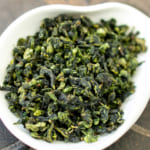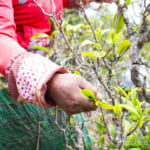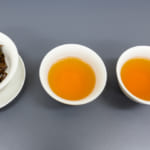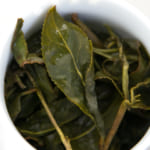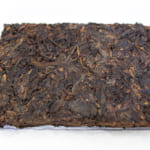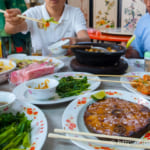- HOME >
- Origin of Tea
HOJO original tailor-made tea from Yunnan
- [2016.04.06] Posted By Akira Hojo
In HOJO’s tea lineup, we have many teas produced in Yunnan Province of China. We are always interested in Yunnan tea because if we work very hard to search we are still able to find some natural farming tea gardens in Yunnan. The quality of tea collected from those natural farming gardens is outstanding; in particular the aftertaste is very long-lasting. However, we also do have a dilemma with Yunnan tea. Many tea manufacturers in Yunnan are very rough in tea handling and processing management. In most cases, the fresh tealeaf is damaged and turned into dark color before it reaches the tea factory. Despite the fresh tea leaf is of good quality, it is often spoiled during the process of tea making. As we are well aware of these problems, we practice unique method to manage the quality of our teas.
Tailor-made tea
Since 2015 we stopped buying the ready-made tea directly from tea manufacturers. Instead, we request the reliable tea manufacturers to produce the tailor-made tea for us. Before 2015, we often visit the tea manufacturer and evaluate the teas they have already produced. We conduct series of tasting and we buy the particular bags of tea if we found the quality is meeting our requirements. Literally we were buying from the manufacturer. However, I felt we could get even better tea if we manage some aspects as follow.
- We select the tea garden and the section to collect fresh tea leaves
- We specify the plucking standard
- We specify the process parameter
Select the ideal tea garden
In Yunnan, tea gardens, especially those consist of old tea trees, are generally owned by the minority ethnics who lives in mountain. They pluck tea and sell the fresh leaves to the tea manufacture. Sometimes they also produce tea themselves and sell as raw pu-erh teas. But their skill in making tea is obviously very unrefined and too wild. They are lack of consistent control on the tea process parameter. They often burn the tea and tea usually has many other quality defects. The tea manufactures purchases tea from many farmers and usually classifies the leaves according to their own criteria. If we want to produce tea from the garden we like, we need to visit there before tea season starts and clearly specify the exact location for the farmers to collect tea. We usually specify the area, garden and what type of tea tree. I usually give them a few criteria to make sure that our teas are collected from the natural farming garden.
Plucking standard
There are a few different plucking standards for pu-erh tea, such as 1 bud 1 leaf, 1 bud 2 leaves, 1 bud 3 leaves and random plucking. The plucking standard affects the flavor and taste of tea. So we always like to determine the plucking standard for the each tea according to cup characteristic we want. For example, we request 1 bud 2 leaves for making Yan Ming Shan raw pu-erh tea in order to emphasize its creamy texture and mellow taste. On the contrary, we request 1 bud and 3-4 leaves for Wu Liang Shan and Ma An Shan raw pu-erh in order to get stronger taste, less bitter and fruity flavor.
Customized process
In making pu-erh tea, there are a huge variance among the manufacturer in regards of withering time and pan-frying method. The longer the withering is conducted, the lesser the moisture remains in tealeaf. Eventually it is very difficult to manage the pan-frying process because of tealeaf with less moisture content will easily burnt. However, if pu-erh tea is produced without sufficient withering process, it tends to give greenish flavor (箐味). Nowadays, there are more and more tea manufacturers conduct very light pan-frying, and the enzyme is still active for further fermentation during the sunshine drying process. With this light pan-frying method, they can get rid of the greenish flavor as floral flavor is developed during the sunshine drying process. Tea gives flavor reminiscent of light fermented oolong tea. However, the lightly pan-fried tea is not very ideal for aging. We always like to manage both withering and pan-frying so as to produce the tea that is nice to drink when it is fresh as well as ideal for aging. Besides pu-erh teas, we also tailor-made our black tea and white tea.
I have been kept visiting Yunnan Province since 2010. But we only started implementing the tailor-made tea production since 2015. For tailor-made tea, we need to responsible for the tea we requested. This method is relatively more risky if we do not know how to determine the tea leaves, agriculture, and manufacturing process. Nevertheless, most importantly we must have a good relationship and mutual understanding with the tea manufacturer to share the philosophy in tea as us did. In fact, we are not the only one who buys tea in tailor-made production style. Some China tea companies who are extremely particular about the quality do practice the tailor-made production too. Since we are improving many aspects year by year, I am pretty much looking forward to tasting the latest tea we commissioned.
Related Articles
How to get the latest update on HOJO Tea?
1. Follow Twitter, 2. Click "Like" on Facebook, and 3. Subscribe in newsletter. You can have the latest tea news from HOJO Tea.
 Subscribe the Newsletter to enjoy the privileges
Subscribe the Newsletter to enjoy the privileges- You may receive a free sample upon purchase, or you may have the priority to purchase special products. So please remember to subscribe our newsletter as well as the social network.
- New Release of Anxi Traditional Oolong
- Anxi, located in Fujian province, China, is celebrated for its Tie Guan Yin tea. However, the Traditional Anxi Oolong from this region boasts a unique fruity aroma, distinguishing it from Tie Guan Yin. Anxi: A Renowned Hub for Oolong Tea Production in China Fujian Province, renowned for its rich tea heritage, boasts several prominent tea-producing …
- New Release of Lan Yun Tie Guan Yin from Anxi
- Lan Yun Tie Guan Yin from Anxi, is not just an ordinary Tie Guan Yin. It has a strikingly delightful flavor reminiscent of orchid flowers with silky-soft drinking sensation. Anxi, renowned as one of the three major Oolong tea production regions in China. Anxi is recognized as one of the three major Oolong tea-producing regions …
NEW ARTICLES
 New Release of Anxi Traditional Oolong
New Release of Anxi Traditional Oolong- Anxi, located in Fujian province, China, is celebrated for its Tie Guan Yin tea. However, the Traditional Anxi Oolong from this region boasts a unique fruity aroma, distinguishing it from Tie Guan Yin. Anxi: A Renowned Hub for Oolong Tea Production in China Fujian Province, renowned for its rich tea heritage, boasts several prominent tea-producing …
 Yunnan 2024 Spring Tea Sourcing
Yunnan 2024 Spring Tea Sourcing- Yunnan Province is globally renowned for the exceptional quality of its tea leaves. However, lax production management often presents challenges in achieving the desired tea quality when relying solely on pre-made teas. To address this issue, we have committed to remaining on-site throughout the spring season to closely monitor tea production. We are meticulously inspecting …
 The Relationship Between Greenness of Tea Leaves and Fertilizer
The Relationship Between Greenness of Tea Leaves and Fertilizer- For both tea and vegetables, there’s a common misconception that a deeper green colour indicates better quality and greater health benefits. However, this isn’t always the case. Natural plants often have a yellowish-green hue rather than a vibrant green. If you observe wild plants in grasslands or along roadsides during spring, you’ll notice that they …
 Creating Muscatel Black Tea Using a Unique Blending Method
Creating Muscatel Black Tea Using a Unique Blending Method- I would like to introduce the unique creation of black tea with a distinctive muscatel flavor profile. Acquiring Exceptional Mi Xiang Black Tea Have you ever heard of a unique black tea called “Mi Xiang Black Tea” or “Muscatel Black Tea”? This tea is crafted from leaves that have been delicately nibbled by leafhoppers, resulting …
 New Release of Lan Yun Tie Guan Yin from Anxi
New Release of Lan Yun Tie Guan Yin from Anxi- Lan Yun Tie Guan Yin from Anxi, is not just an ordinary Tie Guan Yin. It has a strikingly delightful flavor reminiscent of orchid flowers with silky-soft drinking sensation. Anxi, renowned as one of the three major Oolong tea production regions in China. Anxi is recognized as one of the three major Oolong tea-producing regions …
 The Difference Between Fermentation in Tea and Fermented Foods
The Difference Between Fermentation in Tea and Fermented Foods- Black tea and oolong tea are often categorized as “fermented teas,” but the extent to which they undergo fermentation raises questions about whether they truly qualify as fermented foods. In this article, I endeavour to offer a thorough exploration of the distinctions between tea and traditional fermented foods, shedding light on the nuances of their …
 Easy Way to Prepare Flavorful and Warm Tea at the Workplace
Easy Way to Prepare Flavorful and Warm Tea at the Workplace- Have you ever experienced the transformation of tea stored in a thermos or water bottle at work, turning into a brown hue and acquiring a bitter, astringent taste? As this has piqued the interest of many, I would like to offer a more in-depth explanation for a solution. Tea stored in a thermos undergoes oxidation …
 The new release of Bao Dao Shan Da Cha Tou Brick 2017, exclusively crafted from Da Cha Tou leaves
The new release of Bao Dao Shan Da Cha Tou Brick 2017, exclusively crafted from Da Cha Tou leaves- Bao Dao Shan Cha Tou Zhuan 2017 is a ripe pu-erh tea crafted into brick form. Bao Dao Shan is the name of the mountain situated in the southwestern part of Yunnan. “Cha Tou” denotes a distinctive type of ripe pu-erh tea. In the course of fermenting spring tea, certain tea clumps naturally develop, known …
 We released Lapsang Suchong Qi Zhong Classic: Premium Lapsang Souchong
We released Lapsang Suchong Qi Zhong Classic: Premium Lapsang Souchong- Lapsang Souchong is one of the earliest known black teas distinguished by a unique production method and flavour profile. Its origins are often linked to the Wuyi Mountains in China’s Fujian province, where Lapsang Souchong is traditionally crafted. Black tea production in the Wuyi region has a history dating back several centuries. Lapsang Souchong tea …
 Regular Consumption of Umami Seasoning Can Influence Taste Preferences
Regular Consumption of Umami Seasoning Can Influence Taste Preferences- Excessive consumption of artificial condiments, such as umami seasonings, is believed to influence one’s taste and preferences. I’d like to share my own view to explore how an overabundance of condiments can indeed influence one’s palate. Umami Seasonings Are Prevalent in Asian Countries I spend half of the year living abroad, particularly in China and …
Shop Info

Address:Lot No. T-215, 3rd Floor, The Gardens Mall, Mid Valley City, Lingkaran Syed Putra, 59200 Kuala Lumpur
Tel: +603-2287-4537
Business Hour: 10am to 10pm
Category
- New Arrival at HOJO Online Shop
- Featured Articles
- Newsletter
- Types of Tea
- Origin of Tea
- Teapot and Tea Equipment
- Tea Column
- How to enjoy tea
- Tea Processing
- How to choose quality tea
- Tea constituents and functional effect
- Safety of Tea
- Foods
- Tea Business Operation
- Hobby and Outdoor Activity
- Ranking of Tea
- Video
- FAQ
- Media Release
Profile

- AKIRA HOJO
- I invite you to experience my tea selections.I was born in Nagano, Japan. In university, I studied agricultural chemistry, and I have the master degree in food science. I worked in Japanese food industry for 10 years. I involved in R&D, QC and QA. As a factory manager, I implemented ISO9000 series and managed the factory.
- The Art of Tea Magazine
- We posted the article on “The Art of Tea Magazine No.9, the magazine is published in Taiwan. We featured some scientific view about the tetsubin
- New Straits Times
- The Malaysian National Newspaper, New Straits Times featured HOJO Tea on 17-Oct-2007.








